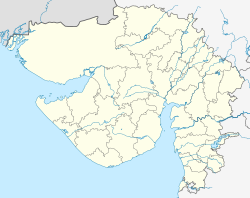Historic City of Ahmadabad
Historic City of Ahmadabad
અમદાવાદ કોટવિસ્તાર | |
|---|---|
Urban settlement | |
 Map of old Ahmedabad in 1855 | |
| Coordinates: 23°1′32″N 72°35′15″E / 23.02556°N 72.58750°E | |
| Country | India |
| State | Gujarat |
| District | Ahmedabad district |
| City | Ahmedabad |
| Established | 1411 |
| Founded by | Ahmad Shah I |
| Criteria | Cultural: (ii), (v) |
| Reference | 1551 |
| Inscription | 2017 (41st Session) |
| Area | 535.7 ha (2.068 sq mi) |
| Buffer zone | 395 ha (1.53 sq mi) |

The Historic City of Ahmadabad or Old
History
The earliest settlements were situated south of the current old city and on the bank of
Forts and Gates
Forts
Square in form, enclosing an area of about forty-three acres, the Bhadra fort had
Gates
Most people believe that Ahmedabad had 12 gates but some historian suggested to have 16. Later some Indologist found that Ahmedabad had 21 gates. Bhadra fort had eight gates, three large, two in the east and one in the south-west corner; three middle-sized, two in the north and one in the south; and two small, in the west.[7] In the city walls of second fort, there were eighteen gates, fifteen large and three small. Of the fifteen, one was closed, and two were added later. These gates were, beginning from the north-west corner, three in the north-wall, the Shahpur in the north-west, the Delhi in the north, and the Dariyapur in the north-east; four in the east wall, the Premabhai, a gate built by British, in the north-east, the Kalupur in the east, the Panchkuva, a gate built by British, in the east, and the Sarangpur in the south-east; four in the south wall, the Raipur and Astodiya in the south-east, and the Mahuda, the closed gate, and the Jamalpur in the south; seven in the west wall, the Khan Jahan, Raikhad and Manek in the south-west; the three citadel gates, Ganesh, Ram, and Baradari in the centre; and the Khanpur gate in the north-west.[8][9] Two new gates, Prem Darwaja and Panchkuva Gate added by British after opening of railways in 1864.[10]
Neighbourhood

Pols were the typical housing cluster of the old city with there being as many as 356 in 1872. This form of housing was established during a time of divided rule from 1738-1753 due to religious tension between Hindu and Muslims. When the city walls deteriorated and no longer provided protection from robbers, the pol gate became more important for protection.[11]
Architecture
The old city features rich wooden architecture, havelis, khadkis, and pols. The wooden architecture is exemplary of the unique heritage and culture in Ahmedabad. It signifies contributions to arts and crafts, traditions, and structure design, and is reflective of the city's occupants. The city's architecture was designed to promote a sense of community, family, and multiculturalism. This is evident in the city being home to institutions belonging to several religions including Hinduism, Islam, Christianity, and Judaism.[12]
References
- ^ "Ahmedabad takes giant leap, becomes India's first World Heritage City". The Times of India. Retrieved 15 July 2017.
- ^ Google Books 2015, p. 249.
- ^ Google Books 2015, p. 252-253.
- ^ Google Books 2015, pp. 260–261.
- ISBN 9788185067094.
- ^ Google Books 2015, p. 248.
- Ahmedabad Mirror. AM. Archived from the originalon 10 April 2013. Retrieved 12 February 2013.
- ^ Pandya, Yatin (23 January 2011). "Ahmedabad gates: Residue of past or the pride of the present?". DNA. Retrieved 11 January 2015.
- ^ Gazetteer of the Bombay Presidency: Ahmedabad. Government Central Press. 1879. pp. 273–277.
- ^ Google Books 2015, p. 262.
- ^ Google Books 2015, p. 294-295.
- ^ Centre, UNESCO World Heritage. "Historic City of Ahmadabad". UNESCO World Heritage Centre. Retrieved 6 December 2022.
Bibliography
- Gazetteer of the Bombay Presidency: Ahmedabad. 7 January 2015. pp. 248–262. Retrieved 1 February 2015 – via Google Books 2015.
 This article incorporates text from this source, which is in the public domain.
This article incorporates text from this source, which is in the public domain.



